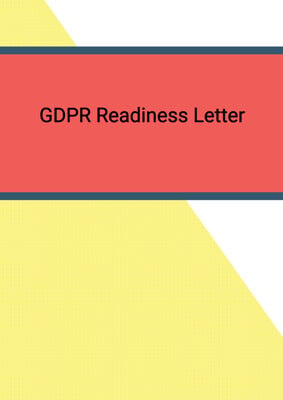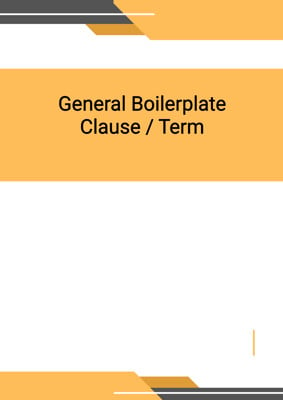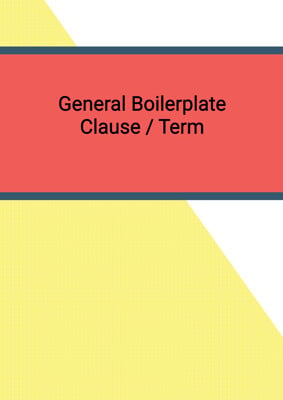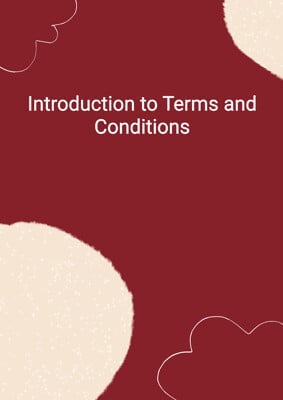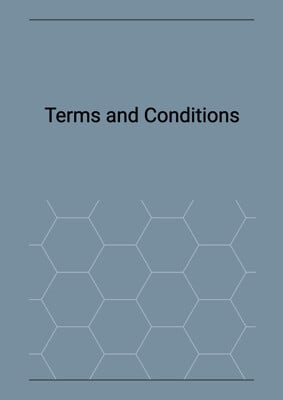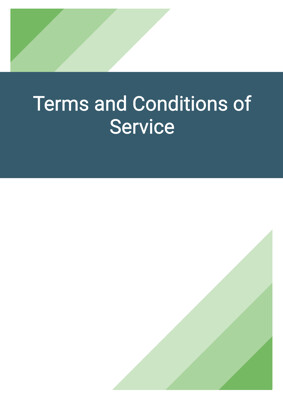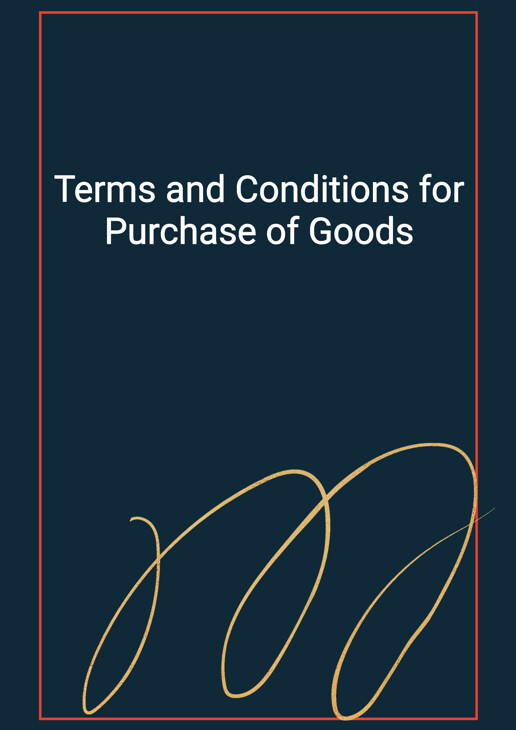
Terms and Conditions for Purchase of Goods
Buyer - Short
This is a set of Standard Terms and Conditions (short form) for the purchase of goods providing a framework for individual sale and purchase transactions drafted in favour of the Buyer. The parties are deemed to have accepted them by transacting without signing.
How to Tailor the Document for Your Need?
01
Create Document
Click "Create Document" button and the document will be prepared with your account details automatically filled in.
02
Fill Information
Please fill in any additional information by following the step-by-step guide on the left hand side of the preview document and click the "Next" button.
03
Get Document
When you are done, click the "Get Document" button and you can download the document in Word or PDF format.
04
Review Document
Please review the document carefully and make any final modifications to ensure that the details are correct before publication / distribution.
Document Preview
Document Description
The document titled 'Terms and Conditions for Purchase of Goods' is a crucial document that outlines the terms and conditions for the purchase of goods between the buyer and the seller. It is important as it establishes the legal framework for the transaction and ensures that both parties are aware of their rights and obligations.
The document begins with a general section that sets out the overall purpose and scope of the terms and conditions. It states that the buyer has placed an order for goods and the seller has accepted the order, thereby creating a binding contract. The document then provides definitions for key terms used throughout.
The document is divided into several sections, each addressing a specific aspect of the purchase agreement. These sections include:
1. Basis of Purchase: This section explains that the order placed by the buyer constitutes an offer to purchase the goods and that the seller's acceptance of the order creates a binding contract. It also clarifies that any typographical or clerical errors in the order can be corrected without liability.
2. Specification: This section outlines the requirements for the quantity, quality, and description of the goods. It states that the goods must comply with the specifications provided by the buyer and be properly marked, packed, and secured for delivery.
3. Price: The price of the goods is stated in the order and may include applicable taxes and charges for packaging, shipping, and delivery. The section also mentions that the buyer may be entitled to discounts for prompt payment or bulk purchase.
4. Payment: This section explains that the seller can invoice the buyer for the goods upon delivery, and the buyer is required to pay the price within a specified timeframe. It also states that the buyer can set off any sums owed to them by the seller against the price.
5. Delivery: The goods are to be delivered to the specified delivery address on the agreed date or within the specified period. The section includes provisions for packing notes, rejection of non-compliant goods, and the buyer's right to claim damages for delayed delivery.
6. Quality: This section sets out the seller's warranty obligations. It states that the goods must be of satisfactory quality, fit for their intended purpose, and comply with the specifications and applicable laws. The section also addresses the seller's liability for any defects or infringements.
7. Risk and Property: This section clarifies that the risk of damage or loss of the goods passes to the buyer upon physical possession, while the property in the goods passes upon delivery or payment.
8. Assignment: The buyer has the right to assign the contract, while the seller requires the buyer's written consent to assign any part of the contract.
9. Warranty: The seller warrants that the goods will meet certain standards and will not infringe any intellectual property rights. The section also includes representations regarding the seller's capacity to enter into the agreement and sell the goods.
10. Indemnity: The seller is required to indemnify the buyer against any liability, loss, damages, costs, or expenses arising from breaches of warranty, infringement claims, or acts or omissions of the seller or its employees.
11. Remedies: The buyer has various remedies in case of non-compliance with the contract, including the right to rescind the order, reject the goods, claim damages, or require the seller to remedy any defects.
12. Termination: The buyer can cancel the contract or terminate it without liability under certain circumstances, such as the seller's insolvency or cessation of business.
13. Force Majeure: If either party is prevented from fulfilling its obligations due to events beyond its control, such as war or natural disasters, that party shall not be considered in breach of the contract. The section includes provisions for notice and termination if the incapacity persists.
14. Communications: All communications between the parties must be in writing and delivered by specified means. The section also addresses the marking of communications and the addresses for each party.
15. Insurance: This optional section states that the seller must maintain liability insurance and provide a certificate of currency to the buyer. It also mentions the seller's responsibility for insuring the goods until the property passes to the buyer.
16. Confidentiality: The seller agrees to keep confidential all the buyer's financial, technological, strategic, or business information related to the agreement. The section includes provisions for electronic communications and restrictions on disclosure.
17. Intellectual Property Rights of the Buyer: This section addresses the seller's obligations regarding goods bearing the buyer's trademarks or branding. It states that such goods must only be sold to the buyer and require the seller's consent for sale to third parties.
18. Waiver: The buyer's waiver of any breach by the seller does not waive subsequent breaches.
19. Severance: If any provision of the conditions is held invalid or unenforceable, it does not affect the validity of the other provisions.
20. No Rights for Third Parties: The contract does not confer any rights on third parties.
21. Governing Law and Arbitration: The contract is governed by the jurisdiction specified.
This document is essential for both the buyer and the seller as it clearly outlines their rights, obligations, and remedies in the event of non-compliance. It provides a comprehensive framework for the purchase of goods and helps to prevent misunderstandings and disputes.
How to use this document?
To use this document effectively, follow these steps:
1. Familiarize yourself with the entire document, paying attention to the definitions and general provisions. Understand the purpose and scope of the terms and conditions.
2. Review each section of the document in detail. Take note of the specific requirements and obligations outlined for both the buyer and the seller.
3. When placing an order, ensure that it complies with the specifications provided by the buyer. Double-check the quantity, quality, and description of the goods.
4. Determine the price of the goods, including any applicable taxes and charges. Consider any discounts that may be available for prompt payment or bulk purchase.
5. Invoice the buyer for the goods upon delivery, quoting the order number. Specify the payment terms and ensure that the price is paid within the agreed timeframe.
6. Arrange for the delivery of the goods to the specified address on the agreed date or within the specified period. Follow the buyer's instructions regarding packaging and packing materials.
7. Inspect the goods upon delivery and ensure that they comply with the contract. If any non-compliance is identified, take the necessary steps to remedy the situation.
8. Manage the risk of damage or loss of the goods by taking appropriate measures during transportation and storage. Transfer the property in the goods to the buyer upon delivery or payment.
9. If any disputes or breaches of the contract arise, refer to the remedies section to determine the appropriate course of action. Consider options such as rescinding the order, rejecting the goods, or claiming damages.
10. In case of termination, follow the specified procedures and obligations. Notify the buyer in writing and comply with any requirements for the return of goods or refund of payments.
11. Keep all communications related to the contract in writing and ensure timely delivery. Address communications to the appropriate party and mark them accordingly.
12. If applicable, maintain the required insurance coverage and provide the buyer with a certificate of currency. Adhere to any additional insurance-related obligations.
13. Safeguard the buyer's confidential information and refrain from disclosing it to third parties without written consent. Take necessary measures to ensure the security of electronic communications.
14. If selling goods bearing the buyer's trademarks or branding, obtain the buyer's consent before selling to third parties. Remove any buyer branding from goods that are rejected or not taken up by the buyer.
15. Familiarize yourself with the governing law and jurisdiction specified in the contract. Understand any provisions related to arbitration if applicable.
By following these steps, you can effectively use the 'Terms and Conditions for Purchase of Goods' document to facilitate a smooth and legally compliant transaction between the buyer and the seller.



